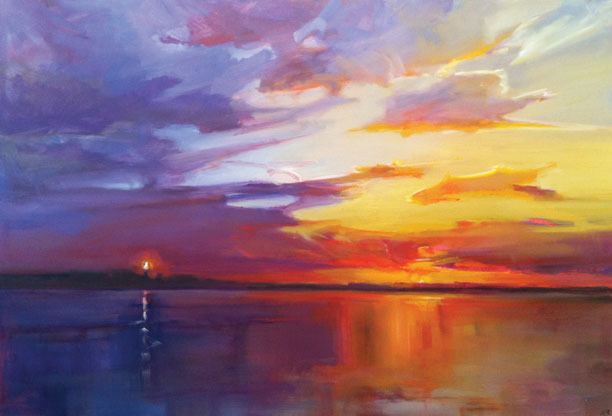Art Collector Maine: A Virtual Marketplace
By Carl Little
Art Collector Maine puts on a show.
Maine has a distinguished place in art history. From Thomas Cole and Frederic Church to Lois Dodd and Yvonne Jacquette, the state has inspired a who’s who of America’s foremost artists. Maine also boasts an incredibly lively art scene. Between top-notch museums and galleries, the cities and towns of Maine—and even a former fort in Brunswick—are practically humming with artists and aesthetic activities. Perfect conditions, you might say, for Art Collector Maine.
Launched in January, the website offers a slide show of Maine artists, their artwork—paintings, sculptures, and mixed-media work—presented in a clean, easy-to-view format. You can search for specific artists, galleries, or genres, or you can just sit back and enjoy the show, moving from, say, one of Andrea Peters’s painterly coastal views to a gleaming stainless-steel Stephen Porter sculpture. When something strikes your fancy—one of John Neville’s stylized fishermen or a ghostly figurative piece by Petrea Noyes or a classic palette-knifed landscape by Tom Curry—you can find more examples on the site or contact the gallery or artist.
The site’s motto might be “connect, inform, engage.” Art Collector Maine seeks to create an online synergy between artists and galleries on the one hand and collectors on the other. The former will use the site as a marketing platform, the latter as a resource for finding out about the remarkable universe of Maine art.
The idea for the site actually began in frustration. Jack Leonardi, a businessman from Kennebunkport, was looking for a sculpture for his backyard. Searching the web, he came across bits and pieces of information—a gallery here, an artist there—but he found the process both inefficient and disjointed. He wanted something similar to the MLS (Multiple Listing Service) in real estate where, in his words, “you really feel like you’re seeing just about everything there is for purchase.”
Leonardi decided to bounce his idea off Maine Home+Design publisher Kevin Thomas: to create a website that would offer a comprehensive overview of Maine art. After meeting on several occasions last year, the two decided to join forces, drawing on Leonardi’s business skills while leveraging some of the infrastructure of the magazine, including its robust social-media platform (including 40,000 Facebook fans). On January 1, 2012, Art Collector Maine went live.
The website, says Leonardi, is only one part of a larger marketing program—“the hub, the aggregating point on the wheel.” He envisions Art Collector Maine becoming an “online forum” with editorial content created to support an inventory of “great Maine art.” He and his team also plan to produce an Art Collector Maine annual catalog and a quarterly mini-magazine, both dedicated to showcasing the artists on the site.
At the same time, a sophisticated email tool will allow art buyers to create a customized profile. If a particular artist intrigues them, they will be alerted when new work is posted or a show is happening.
Leonardi acknowledges that many galleries and artists already have websites or Facebook pages, but they are often underutilized or out of date. “They don’t have the resources to fully take advantage of the medium,” he says, whereas the magazine has staff dedicated to managing its social-media database. They can monitor what is working and thereby keep the messages engaging.
Jill Hoy, a painter who divides her time between Boston and Stonington, has had her own website for many years. “A lot of people look at it and periodically I sell from it,” she notes, but she hasn’t had time to streamline or modernize it. She likes the “minimalism” of Art Collector Maine, how it “shows off the work beautifully.” Indeed, her signature bold, bright landscapes look grand.
Art Collector Maine also advertises more widely than Hoy could afford to (she mentions an ad for the site in ARTnews, part of a national marketing campaign to bring collectors from outside Maine to the website). She hopes that searching for art online inspires collectors to visit galleries and studios “to experience the act of looking, which is so nurturing and thrilling.”
Matt Welch, owner of the Flat Iron Gallery, one of the newest art venues in Portland (he opened last September), also notes that Art Collector Maine isn’t meant to be a “replacement for the physical gallery.” At the same time, Welch observes, “the Internet is gaining momentum, and people are changing the way they buy art.” He also likes the idea of showcasing Maine art. The state has a special spirit “and people like to tune in to that,” wherever they may be.
Art Collector Maine doesn’t conduct transactions, and there are no commissions on sales; collectors make contact with galleries or artists on their own or through the site. As of mid-February, more than 20 galleries representing nearly 150 artists (either individually or through a gallery) had signed on. One phenomenon Leonardi and company had not anticipated: a number of galleries have successfully solicited financial participation from their artists.
Art Collector Maine is part of a larger trend toward marketing art on the Internet. Such international sites as Art.sy and Paddle8.com demonstrate that, even at the top end of the art world, collectors are using virtual venues to search for new work. “There is a place for an online gallery,” Leonardi states with conviction, and he aims to create the best one for Maine.








